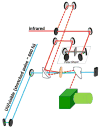Equilibrium versus Nonequilibrium Peptide Dynamics: Insights into Transient 2D IR Spectroscopy
- PMID: 30040900
- PMCID: PMC6160340
- DOI: 10.1021/acs.jpcb.8b05063
Equilibrium versus Nonequilibrium Peptide Dynamics: Insights into Transient 2D IR Spectroscopy
Abstract
Over the past two decades, two-dimensional infrared (2D IR) spectroscopy has evolved from the theoretical underpinnings of nonlinear spectroscopy as a means of investigating detailed molecular structure on an ultrafast time scale. The combined time and spectral resolution over which spectra can be collected on complex molecular systems has led to the precise structural resolution of dynamic species that have previously been impossible to directly observe through traditional methods. The adoption of 2D IR spectroscopy for the study of protein folding and peptide interactions has provided key details of how small changes in conformations can exert major influences on the activities of these complex molecular systems. Traditional 2D IR experiments are limited to molecules under equilibrium conditions, where small motions and fluctuations of these larger molecules often still lead to functionality. Utilizing techniques that allow the rapid initiation of chemical or structural changes in conjunction with 2D IR spectroscopy, i.e., transient 2D IR, a vast dynamic range becomes available to the spectroscopist uncovering structural content far from equilibrium. Furthermore, this allows the observation of reaction pathways of these macromolecules under quasi- and nonequilibrium conditions.
Figures










Similar articles
-
Two-dimensional infrared spectroscopy of photoswitchable peptides.Annu Rev Phys Chem. 2008;59:291-317. doi: 10.1146/annurev.physchem.59.032607.093757. Annu Rev Phys Chem. 2008. PMID: 17988202 Review.
-
2D-IR spectroscopy: ultrafast insights into biomolecule structure and function.Chem Soc Rev. 2009 Jul;38(7):1837-48. doi: 10.1039/b819181f. Epub 2009 Mar 27. Chem Soc Rev. 2009. PMID: 19551165 Review.
-
Ultrafast structural molecular dynamics investigated with 2D infrared spectroscopy methods.Top Curr Chem (Cham). 2017 Oct 25;375(6):86. doi: 10.1007/s41061-017-0172-1. Top Curr Chem (Cham). 2017. PMID: 29071445 Review.
-
Amide I two-dimensional infrared spectroscopy of proteins.Acc Chem Res. 2008 Mar;41(3):432-41. doi: 10.1021/ar700188n. Epub 2008 Feb 21. Acc Chem Res. 2008. PMID: 18288813 Review.
-
Using 2D-IR Spectroscopy to Measure the Structure, Dynamics, and Intermolecular Interactions of Proteins in H2O.Acc Chem Res. 2024 Mar 5;57(5):685-692. doi: 10.1021/acs.accounts.3c00682. Epub 2024 Feb 16. Acc Chem Res. 2024. PMID: 38364823 Free PMC article. Review.
Cited by
-
Photo-initiated rupture of azobenzene micelles to enable the spectroscopic analysis of antimicrobial peptide dynamics.RSC Adv. 2020 Jun 7;10(36):21464-21472. doi: 10.1039/d0ra01920h. Epub 2020 Jun 4. RSC Adv. 2020. PMID: 32879729 Free PMC article.
-
Ultrafast Dynamics at Lipid-Water Interfaces.Acc Chem Res. 2020 Sep 15;53(9):1860-1868. doi: 10.1021/acs.accounts.0c00302. Epub 2020 Aug 31. Acc Chem Res. 2020. PMID: 32866390 Free PMC article.
-
Biomolecular infrared spectroscopy: making time for dynamics.Chem Sci. 2023 Nov 28;15(2):414-430. doi: 10.1039/d3sc05223k. eCollection 2024 Jan 3. Chem Sci. 2023. PMID: 38179520 Free PMC article. Review.
-
Recent developments in the computational study of protein structural and vibrational energy dynamics.Biophys Rev. 2020 Apr;12(2):317-322. doi: 10.1007/s12551-020-00661-0. Epub 2020 Mar 2. Biophys Rev. 2020. PMID: 32124240 Free PMC article. Review.
References
-
- Donaldson PM, Hamm P. Gold Nanoparticle Capping Layers: Structure, Dynamics, and Surface Enhancement Measured Using 2D-IR Spectroscopy. Angew Chemie-International Ed. 2013;52(2):634–638. - PubMed
-
- Ramakers LA, Hithell G, May JJ, Greetham GM, Donaldson PM, Towrie M, Parker AW, Burley GA, Hunt NT. 2D-IR Spectroscopy Shows That Optimized DNA Minor Groove Binding of Hoechst33258 Follows an Induced Fit Model. J Phys Chem B. 2017;121(6):1295–1303. - PubMed
-
- Khalil M, Demirdoven N, Tokmakoff A. Coherent 2D IR Spectroscopy: Molecular Structure and Dynamics in Solution. J Phys Chem A. 2003;107(27):5258–5279.
-
- Reid GD, Wynne K. Encyclopedia of Analytical Chemistry. John Wiley & Sons, Ltd; 2006. Ultrafast Laser Technology and Spectroscopy.
Publication types
MeSH terms
Substances
Grants and funding
LinkOut - more resources
Full Text Sources
Other Literature Sources
Miscellaneous

